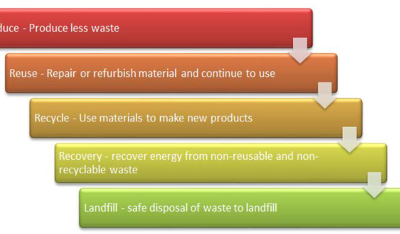The different problems are explained more in detail in this section (European Environment Agency (2014)): Air emissions: If the waste of a city is not managed in a sustainable way, much of it will be disposed in landfills or burned in waste treatment facilities....
Waste
A big problem modern society are facing these days, is the enormous amount of generated waste. Especially cities with many inhabitants are producing a huge amount of waste and the trend is rising, due to an increase in the consumption of the population. It is expected that close to 70 per cent of the global population will be living in urban areas by 2050. Currently, solid waste landfills in and around cities are contributing to high levels of air pollution, which has a negative effect on the health of millions of people around the world. Additionally, as global population growth is increasing rapidly, the consumption of resources for material goods is skyrocketing. This creates an urgent need for us to rethink the way we dispose of waste in the cities.
The problems, resulting of bad waste management should not be underestimated. The endangerment of ecosystems like the sea by littering, the production of greenhouse gases that are accelerating the climate change or the loss of material are just some of the immense ecological problems occurring. The challenge of a smart and circular city is to minimize such issues by a well-working waste management and policy (European Environment Agency (2014)).
A circular city has to give a framework for a waste management that is sustainable. Legal restrictions and the motivation of citizens to contribute are ways to positively affect the waste management to shift the city to a “zero waste city”. Urban waste also represents a largely untapped source of recyclable materials for production, reusable goods as well as a source of both heat and electricity when properly utilised in efficient waste-to-energy plants. Along with the numerous environmental and health issues caused by our consumption and disposal patterns, this must be addressed to help shape the liveable and sustainable cities of tomorrow.
Legal and political factors
There are many regulations and agreements on the European level that are aiming at the reduction of generated waste and the increase of reusing waste. The European green deal for example, provides guidelines how to reduce and how to reuse the waste. The main...
Social and cultural factors
Even if waste is not the most social topic, there are still a few administrative things to be aware of when it comes to waste management. How already mentioned, in the environmental section, the reduction of waste is the most effective way to prevent environmentally...
Technological factors
There are plenty of technologies and innovations that are able to improve the waste management of a city and make it more sustainable. The fields of application for those technologies vary. The most common technologies that are supporting the waste management are high...
Examples of innovative solutions
An innovative example, how a smart city could improve the waste management can be found in the city Nitra in Slovakia. In 2015 the company “SENSONEO” started to equip public garbage collection bins with sensors that are able to measure the filling level of the...
References
Circular Cities Declaration (2020), Key Circular Economy sectors, [online] https://circularcitiesdeclaration.eu/cities-and-the-circular-economy/key-sectors(accessed: 2021/12/28)European Commission (2015), Waste,...
More information
EU EU waste policy aims to contribute to the circular economy by extracting high-quality resources from waste as much as possible. The Waste Framework Directive (2008) is the EU’s legal framework for treating and managing waste in the EU. It...
Animation goes here



